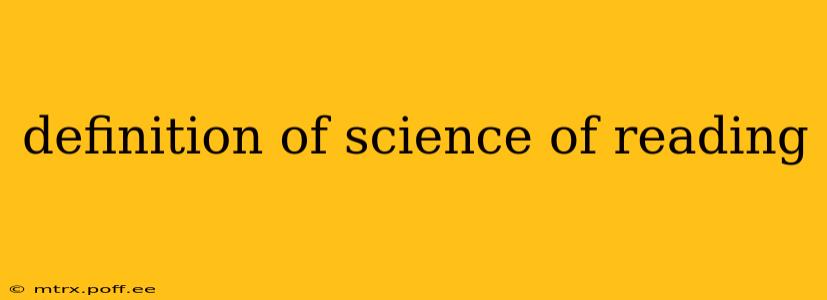The Science of Reading is a research-based approach to teaching reading that emphasizes the systematic and explicit instruction of the foundational skills necessary for reading proficiency. It's not a single method but rather a framework grounded in scientific understanding of how the brain learns to read. This approach moves beyond phonics-only instruction to encompass a broader understanding of the complex cognitive processes involved in reading acquisition.
What are the Core Components of the Science of Reading?
The Science of Reading integrates several key components, all supported by robust scientific evidence:
-
Phonemic Awareness: This is the ability to hear and manipulate the individual sounds (phonemes) in spoken words. Activities like rhyming, blending sounds, and segmenting words are crucial for developing phonemic awareness. Strong phonemic awareness is a significant predictor of later reading success.
-
Phonics: This involves the understanding of the relationship between letters and sounds. Students learn to decode (read) and encode (spell) words by connecting graphemes (letters or letter combinations) to phonemes. Systematic and explicit phonics instruction is vital for building decoding skills.
-
Fluency: Once students can decode words, they need to practice reading with speed, accuracy, and expression. Fluency allows students to focus on comprehension rather than struggling with individual words. Repeated readings and opportunities for oral reading are key to building fluency.
-
Vocabulary: A rich vocabulary is essential for comprehension. Students need to learn the meanings of new words, both through direct instruction and through wide reading. This includes understanding the nuances of word meanings and how words relate to each other.
-
Reading Comprehension: This is the ultimate goal of reading instruction. It involves understanding the meaning of text, making inferences, and connecting the text to prior knowledge. Comprehension strategies, such as asking questions, visualizing, and summarizing, are vital for improving comprehension skills.
-
Phonological Memory: This refers to the ability to hold and process sounds in short-term memory. It's crucial for tasks like learning new words and remembering sequences of sounds in spoken language. Activities that challenge phonological memory can enhance reading skills.
-
Orthographic Processing: This is the ability to recognize and recall letter patterns and spelling patterns within words. Strong orthographic processing improves speed and accuracy in reading and spelling.
How Does the Science of Reading Differ from Traditional Methods?
Traditional reading instruction often relied on whole-language approaches, emphasizing reading for meaning before mastering foundational skills. The Science of Reading, however, prioritizes explicit and systematic instruction in phonemic awareness, phonics, and other foundational skills, acknowledging that these skills are the building blocks for reading comprehension. It's about building a solid foundation before moving on to more complex reading tasks.
What are the Benefits of the Science of Reading?
The benefits of implementing the Science of Reading are substantial:
-
Improved Reading Skills: Studies show that students taught using the Science of Reading make significant gains in reading fluency and comprehension.
-
Reduced Reading Difficulties: Early and effective instruction can prevent or mitigate reading difficulties, such as dyslexia.
-
Increased Reading Enjoyment: Students who are confident and skilled readers are more likely to enjoy reading and engage in it independently.
What are some common misconceptions about the Science of Reading?
Is the Science of Reading just about phonics?
No. While phonics is a crucial component, the Science of Reading encompasses a broader range of skills, including phonemic awareness, fluency, vocabulary, and comprehension. It's about a balanced and integrated approach.
Is the Science of Reading a one-size-fits-all approach?
While the core principles are universal, the implementation of the Science of Reading should be tailored to meet the individual needs of each student. Differentiated instruction is crucial for ensuring that all students receive the support they need to succeed.
Is the Science of Reading too difficult for young learners?
Research shows that young children are capable of learning the foundational skills necessary for reading. The key is to provide explicit and engaging instruction that is appropriate for their developmental level.
The Science of Reading provides a powerful framework for teaching reading effectively. By focusing on research-based practices, educators can ensure that all students have the opportunity to become confident and skilled readers. This leads to improved academic outcomes and a lifelong love of reading.
